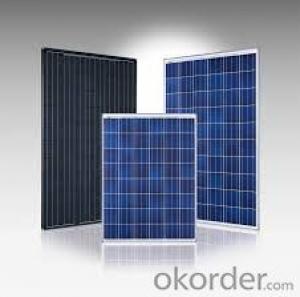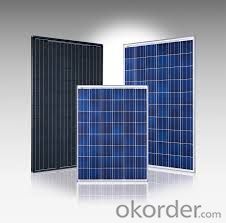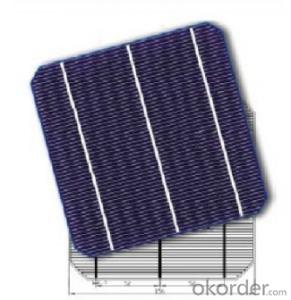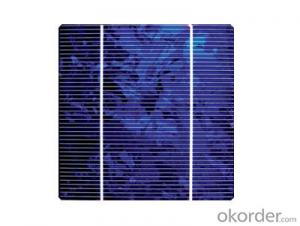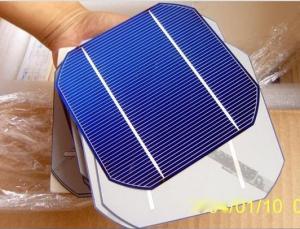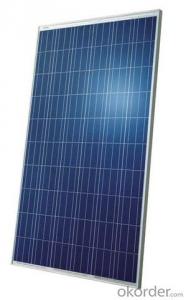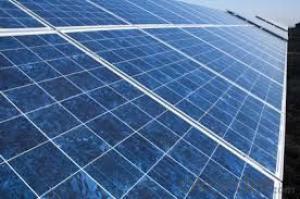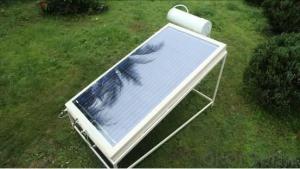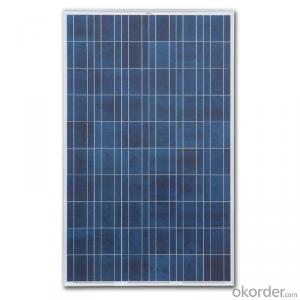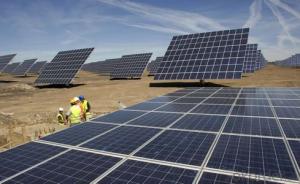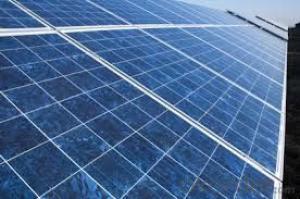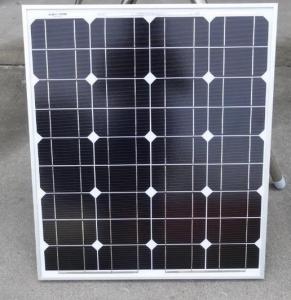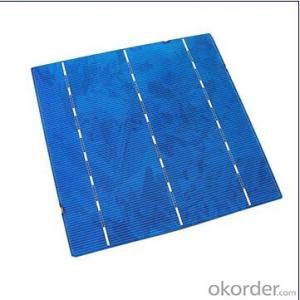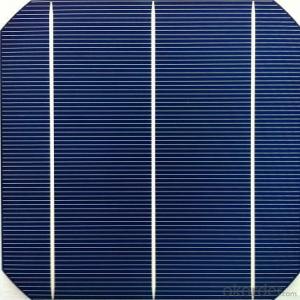Carbon Solar Cells Factory Direct Sale Polycrystalline Solar Panel with High Quality CNBM
- Loading Port:
- Qingdao
- Payment Terms:
- TT OR LC
- Min Order Qty:
- 10 set
- Supply Capability:
- 300000 set/month
OKorder Service Pledge
OKorder Financial Service
You Might Also Like
Polycrystalline Solar Modules
CNBM offers a range of small, medium and large polycrystalline solar modules, designed for a range of requirements.
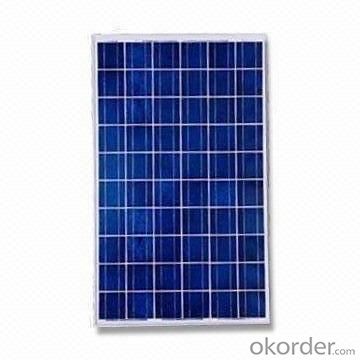
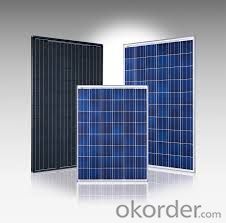
Specifications:
Tolerance | +/-3% |
Cell | Polycrystalline silicon solar cells (156 x 156mm) |
N0. of Cells | 60 (10 x 6) |
Dimension of Modules (mm) | 1650 x 990 x 40 |
Weight (kg) | 25.5 |
Limits:
Operating Temperature | -40~+85? |
Storage Temperature | -40~+85? |
Maximum System Voltage | 1000 VDC max. |
Hail Impact | Diameter of 28mm with impact speed |
Temperature and Coefficients:
NOCT | 48C+/-2? |
Voltage temperature coefficient (%/K) | -0.35 |
Current temperature coefficient (%/K) | 0.05 |
Power temperature coefficient (%/K) | -0.45 |
Characteristics:
Model: | SGM-200P | SGM-210P | SGM-220P |
Max-power voltage Vmp (V) | 29.2 | 29.4 | 29.41 |
Max-power current Imp (A) | 6.85 | 7.14 | 7.48 |
Open-circuit voltage Voc (V) | 36.5 | 36.69 | 36.9 |
Short-Circuit Current Isc (A) | 7.28 | 7.6 | 7.93 |
Max-power Pm(W) | 200 | 210 | 220 |
Model: | SGM-230P |
Max-power voltage Vmp (V) | 29.8 |
Max-power current Imp (A) | 7.72 |
Open-circuit voltage Voc (V) | 37.31 |
Short-Circuit Current Isc (A) | 8.19 |
Max-power Pm(W) | 230 |
STC: Irradiance 1000W/m2, module temperature 25?, AM-=1.5
Poly Crystalline Solar Panels Specifications Range
Maximum Power (Pm) | Dimension | Weight | Operating Voltage (Vmp) | Operating Current (Imp) | Open Circuit Voltage (Voc) | Short Circuit Current (Isc) |
0.45W | 140x80x10mm | 0.08kg | 3.3V | 150mA | 4.6V | 160mA |
1.0W | 162x140x10mm | 0.16kg | 7.5V | 150mA | 10.3V | 160mA |
4.5W | 269x251x23mm | 0.8kg | 16.5V | 0.27A | 20.5V | 0.3A |
10W | 420.1×268.9×22.6mm | 1.92kg | 17.5V | 0.58A | 20.5V | 0.6A |
20W | 425x502x50mm | 3.0kg | 16.8V | 1.19A | 21.0V | 1.29A |
30W | 593x502x22.6mm | 3.9kg | 16.8V | 1.78A | 21.0V | 1.94A |
40W | 655x537x50mm | 5.75kg | 17.3V | 2.31A | 22.1V | 2.54A |
50W | 839x537x50mm | 6.0kg | 17.5V | 2.9A | 21.8V | 3.17A |
65W | 1111x502x50mm | 7.2kg | 17.6V | 3.69A | 22.1V | 3.99A |
80W | 1204x537x50mm | 7.7kg | 17.6V | 4.55A | 22.1V | 4.8A |
- Q: Can solar cells be used for powering concert venues?
- Yes, solar cells can be used for powering concert venues. Solar panels can be installed on the roof or surrounding areas of the venue to capture sunlight and convert it into electricity. This renewable energy source can help reduce the carbon footprint of the venue and provide a sustainable solution for powering concerts.
- Q: What is the impact of tree shading on solar cell performance?
- Tree shading has a significant negative impact on solar cell performance as it reduces the amount of sunlight reaching the cells, thereby reducing the overall energy output. Shading blocks direct sunlight and creates uneven distribution of light, resulting in decreased efficiency and potentially even causing parts of the cells to operate in reverse, leading to further energy loss. It is crucial to plan solar installations carefully, considering tree growth and shading patterns, to maximize solar cell performance.
- Q: What is the role of solar cells in powering electric fences?
- The role of solar cells in powering electric fences is to convert sunlight into electrical energy, which is then stored in batteries. This stored energy is used to power the electric fence, providing a continuous and reliable source of electricity without the need for a traditional power source or connection to the electrical grid.
- Q: What is the role of inverters in solar cell systems?
- The role of inverters in solar cell systems is to convert the direct current (DC) generated by the solar panels into alternating current (AC) that can be used to power household appliances and be fed back into the electrical grid. Inverters also ensure that the solar system operates efficiently by monitoring the voltage and current, maximizing power output, and providing safety features such as ground-fault protection.
- Q: What is the impact of solar cells on reducing greenhouse gas emissions?
- Solar cells have a significant impact on reducing greenhouse gas emissions as they generate clean and renewable energy from sunlight, without emitting any greenhouse gases. By replacing fossil fuel-based electricity generation, solar cells help reduce the carbon dioxide and other harmful emissions that contribute to climate change. This transition towards solar energy plays a crucial role in mitigating global warming and creating a more sustainable future.
- Q: Can solar cells be used in countries with limited sunlight?
- Yes, solar cells can still be used in countries with limited sunlight. While solar cells are most efficient in areas with abundant sunlight, they can still generate electricity even in regions with limited sunlight. Advances in technology have made solar cells more efficient and capable of capturing and converting sunlight into electricity even in low-light conditions. Additionally, solar cells can be combined with battery storage systems to store excess energy generated during sunny periods for use during cloudy or nighttime hours. Thus, solar cells can be a viable and sustainable energy solution in countries with limited sunlight.
- Q: What is the impact of solar cells on job creation?
- The impact of solar cells on job creation is significant. The solar industry has seen a rapid growth in recent years, leading to a surge in job opportunities. Solar cell manufacturing, installation, maintenance, and research and development have all created a wide range of employment opportunities. This growth has not only created jobs in the renewable energy sector but has also generated indirect employment in related industries. Additionally, the shift towards solar energy has encouraged innovation and entrepreneurship, further contributing to job creation. Overall, solar cells have had a positive impact on job creation by driving economic growth and fostering a sustainable workforce.
- Q: I have a turnkey solar power project starting in 6 months, now we are searching the market in south China to find the best solar cells manufacturers. Any professional suggestion or recommendation?
- How big is your project? Is it a turnkey project or something else? How about your budget? And the finishing date of the project? These are the questions you need to make sure you are clear about the answer.
- Q: How efficient are solar cells?
- Solar cells are highly efficient in converting sunlight into electricity, with the most advanced ones achieving an efficiency of around 20-25%. However, the average efficiency of commercially available solar panels is typically around 15-20%.
- Q: Can solar cells be used for powering traffic lights?
- Yes, solar cells can be used for powering traffic lights. Solar cells convert sunlight into electricity, which can be stored in batteries and used to power various devices, including traffic lights. This helps reduce dependence on the electrical grid and promotes renewable energy use.
Send your message to us
Carbon Solar Cells Factory Direct Sale Polycrystalline Solar Panel with High Quality CNBM
- Loading Port:
- Qingdao
- Payment Terms:
- TT OR LC
- Min Order Qty:
- 10 set
- Supply Capability:
- 300000 set/month
OKorder Service Pledge
OKorder Financial Service
Similar products
Hot products
Hot Searches
Related keywords
